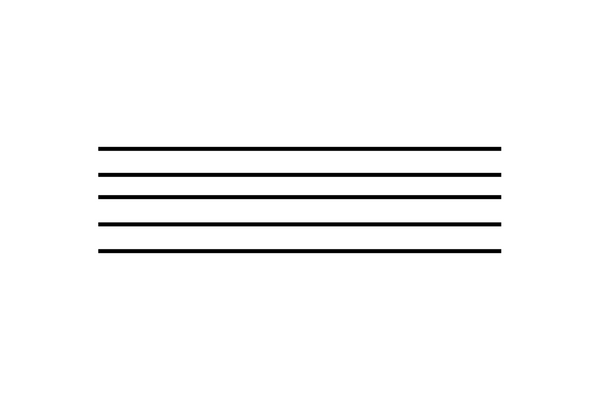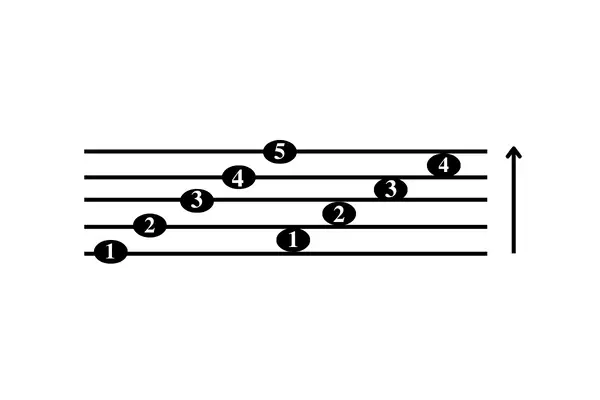Did you know the music staff is the primary tool used to read music?
If you’re a musician, then you may already know that the staff is one of the most important tools for reading music. But do you know the simplest way to read the staff?
Yes, there is a very easy way to read it quickly.
Let me show you how.
- Did you know the music staff is the primary tool used to read music?
- What is a Staff in Music?
- What is a Staff Musical Symbol?
- Why is a Staff Important in Music?
- Why is Music Written Down on a Staff?
- What is the Difference Between Staff and Stave?
- What is the Name of the 5 Lines and 4 Spaces in Music?
- How Many Staves Are There in Music?
- Who Invented the Music Staff?
- Music Staff Summary
- Music Staff Lesson and Cheat Sheet
- More Basic Music Theory Lessons
In a hurry? Grab this quick music staff lesson and cheat sheet. Print this PDF instantly at home.
Basic Music Theory Lesson #1 - The Music Staff Lesson and Cheat Sheets
A quick music staff lesson and cheat sheet. This is the first in a series of basic music theory lessons that you don't want to miss! Add this instant digital download PDF to your music theory binder and use it as a quick reference or study guide. You can easily print it at home or at a copy shop on 8 1/2 x 11 inch paper.
What is a Staff in Music?
A staff in music is the home of musical notation. It’s where music notes and symbols reside. Sounds (pitch), or notes, are written on this basic framework. The music staff has five horizontal lines that run parallel to each other with four spaces in between.

The lines and spaces are numbered from bottom to top. We read the staff starting at the bottom and move up towards the top.

All in all, it’s a very useful tool for musicians!
In addition to holding musical notation, the staff also holds important information about rhythm, pitch, meter, dynamics, articulation, and more. The staff has been around since ancient times and used by early civilizations. It is still widely used today across the world.
In case you still need more help in understanding how to read the music staff, here is a list of commonly asked questions.
What is a Staff Musical Symbol?
The staff musical symbol consists of five horizontal lines and four spaces between the lines that hold music notes. Notes written on the staff indicate a specific pitch by using a clef sign that appears at the start of the staff.
Why is a Staff Important in Music?
The staff is important in music because it clearly communicates music notation. Music notes, rests, and other symbols are placed on the staff and sometimes directly above or below. This tells a musician exactly what to play on their instrument or sing.
Why is Music Written Down on a Staff?
Music is written down on a staff using notes, rests, and other music symbols. This represents the sound and silence of music. A staff has five lines and four spaces. Notes are written on the staff with a clef sign indicate pitch.
What is the Difference Between Staff and Stave?
The difference between staff and stave is whether more than one staff is being used. A staff is just one set of five horizontal lines. Stave is the plural form of staff. When more than one staff is used in written music, it is then called “staves.”
What is the Name of the 5 Lines and 4 Spaces in Music?
The staff is the name of the system that uses 5 lines and 4 spaces in music. Music notes, rests, and other important music symbols are written on the staff. When more than one staff is used to write and read music, the word “staves” is used instead.
How Many Staves Are There in Music?
There are four staves used most often in music. Clef signs are placed at the beginning of a staff to indicate the pitch of notes. The most common staves used are the treble clef staff, bass clef staff, alto clef staff, and the tenor clef staff.
Who Invented the Music Staff?
Guido d’Arezzo is credited with inventing the music staff. He introduced the idea of using four lines instead of one or two. His system became widely adopted throughout Europe.
His method of teaching music was revolutionary. Before he came along, musicians had to memorize hundreds of songs and pieces of music. By writing down the notes on paper using staff notation, he made learning music easier and faster.
Ugolino da Forlí is credited with promoting the use of five-line staves. He wrote several books on musical notation advocating the benefits. Five-line staves are still in use and have become the standard in written music.
The current music staff of five lines evolved from the early predecessor of just one or two lines. Neumes (the earliest style of music notes) were placed on the lines or spaces to guide musicians with pitch.
According to Wikipedia, the four-line staff Arezzo created is still used today in Gregorian Chant publications.
Today, the music staff remains a fundamental part of modern music theory. It allows musicians to easily write complex melodies and harmonies in the simplest way possible.
Music Staff Summary
The music staff is one of the most important tools for reading music. It has five horizontal lines with four spaces between the lines. To read the staff quickly, start at the bottom and move towards the top.
Here’s a fun fact: Anything you count in music (staff lines and spaces, scale degrees, intervals, guitar strings, etc.) is always counted from bottom to top.
Music Staff Lesson and Cheat Sheet
Want this quick music staff lesson and cheat sheet? You can grab this music theory PDF here. Download and print instantly.
More Basic Music Theory Lessons
50+ Free Music Theory Lessons for Beginners

![Music Staff Lesson and Cheat Sheet [Basic Music Theory Lesson 1]](https://www.musicreadingsavant.com/wp-content/uploads/2022/11/music-staff-lesson-and-cheat-sheet-basic-music-theory.png)